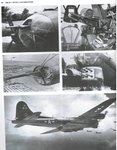Tony Williams
Airman 1st Class
I have to say that the precision of the figures you quote makes me suspicious. How could they know what hit rates were achieved at different ranges in the chaos of combat? The only possible sources for this information - the aircrew involved - would have been far too busy to make a careful note of this even if they knew, particularly since estimation of the ranges in air-to-air combat was notoriously inaccurate.Hi Tony,
>German sources obviously differ about the percentage of shots fired which hit the targets: I have seen two figures quoted, of 2% and 5%.
Well, obviously the above figures are quite accurate and specific to the respective weapon and range, while "2%" or "5%" look much like arbitary assumptions.
>The second point is this: just because fighter guns were harmonised for a particular range doesn't mean that this was the expected kill range.
It certainly means that it was the expected effective range. And effective range is the range at which a kill or serious damage will result from hits.
I would say that it represents the maximum range at which hits might be expected to be scored. As we know, a B-17 required many 20mm hits to be brought down, so it could take a long time to acccumulate those hits at long range.

